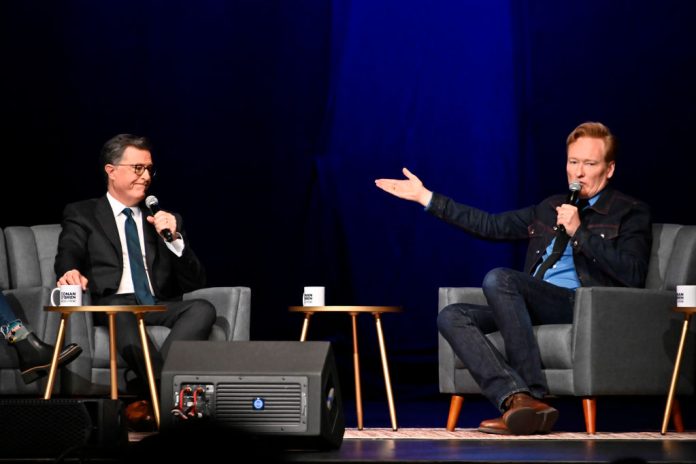Late-night talk show hosts are intertwined with the meteoric rise of television. From Steve Allen and Johnny Carson to Jon Stewart and Bill Maher, they have helped shape the voice of broadcast and cable across various eras. Yet, when hosts such as Hasan Minhaj, Chelsea Handler, David Letterman, John Mulaney and others have attempted to adopt or reinvent the format for streaming, they have not been met with the same success.
Has the quality of our talk show hosts somehow declined over the last few decades? Or, like the social opinions of many of our parents, has the format truly reached irrelevance in its old age? Streaming offered creative freedom unfettered by FCC broadcast standards and a seemingly endless budgetary runway. However, the medium’s on-demand culture has never meshed with the timely appointment viewing that made late-night such a revelation on linear TV.
The numbers don’t lie
Early on, broadcast late-night TV was defined by a few key criteria that made it such a valuable product: heaps of ad revenue from live nightly broadcasts, lower production costs compared with scripted programming, and reliably consistent scheduling that drove habitual tune-in every night. (While costs for late-night on broadcast have ballooned to more than $100 million a year while generating not enough revenue, one can see how that model worked for decades.)
Streaming is built entirely differently. Netflix popularized the cost-plus model, in which producers are paid an upfront flat fee premium, while ad revenue remains minimal today. Batch and binge releases train audiences to consume in short bursts of hyper-engagement rather than regularly scheduled repeatable tune-ins.
Though some of Netflix’s talk show projects ended before the streamer began releasing engagement reports in 2023, the data we do have still speaks volumes. In the past two years, John Mulaney’s Everybody’s in L.A. and Everybody’s Live, Hasan Minhaj’s Patriot Act, Chelsea Handler’s Chelsea Does and David Letterman’s My Next Guest Needs No Introduction have all struggled to generate more than a few million hours viewed, according to Netflix’s ratings reports. Putting aside quality, they’ve more or less been met with weak engagement, low retention and niche audience appeal despite the fact that Netflix leads TV sources as the preferred destination for entertainment late at night, per Hub Entertainment Research.
The deeper question is why.
Talk shows don’t work on streaming (yet)
Three main factors are contributing to late-night’s decline: functionality mismatches, new media replacements, and discovery and marketing obstacles.
The enduring appeal of streaming is that it shifts the control from the programmers to the viewers. We can watch anything we want, anytime we want, at any pace we want. That on-demand flexibility is rarely conducive to regular routine for non-scripted entertainment (excluding sports like WWE). The fact that Netflix measures its most-watched programming by viewership in the first 90 days says a lot about how the windows of success are longer in streaming than on linear. Streamers are betting on viewers returning to their favorites and most-anticipated over time. In contrast, late-night revolves around timely and topical humor that affords practically zero catch-up and rewatch value. If you miss it, poof, it’s gone in your mind. No one cares about last week’s headlines.
Talk show formats live at a very special intersection of news and comedy. Those just so happen to be the primary lanes that social media and podcasts are eating into most. Today, four in ten adults under 30 and one in four over 30 (under 49) get news from TikTok, and the share is growing, according to Pew Research.
One element contributing to CBS’s cancellation of Stephen Colbert was that the “Late Show has by far the smallest digital footprint on YouTube and other platforms,” per Puck News. Comedian Mike Birbiglia echoed a similar sentiment for his side of the tracks when he said on The Town that “podcasts are where people go to find comedy at this point.” There just isn’t a lot of room for this type of entertainment to live these days, at least in its original-ish form. (By the way, Netflix is moving into podcasts.)
Late-night and talk show formats don’t have a natural fit within streaming’s algorithm-driven model, which runs on genre specificity. If you like true crime, it recommends more true crime. If you like superheroes, it recommends more superheroes. The topical variety of talk shows exists in a disconnected bucket with very little genre affinity to others.
Unlike massive streaming originals such as Stranger Things or The Boys, these platforms struggle to market a regularly recurring program without a central hook. Splashy guest? Viewers can just go directly to that celeb’s social channels to get their fix. Humor? Go and check out the thousands of stand-up specials available on the same platform. Streamers haven’t yet found a clear viewer incentive to spur live tune-in.
Final takeaway
The elements that once made late-night programming great—familiar consistency, topical comedy, rare celebrity access, and financial feasibility—are almost diametrically opposed to streaming logic and how it has trained audience behavior. Hosts like Minhaj, Letterman, Handler, and Mulaney continue playing with form and function. Much of it has been highly entertaining, but it has yet to be consistently commercially successful. They are fighting on an entirely different battlefield than the Carsons, Lenos and Stewarts of the past.


